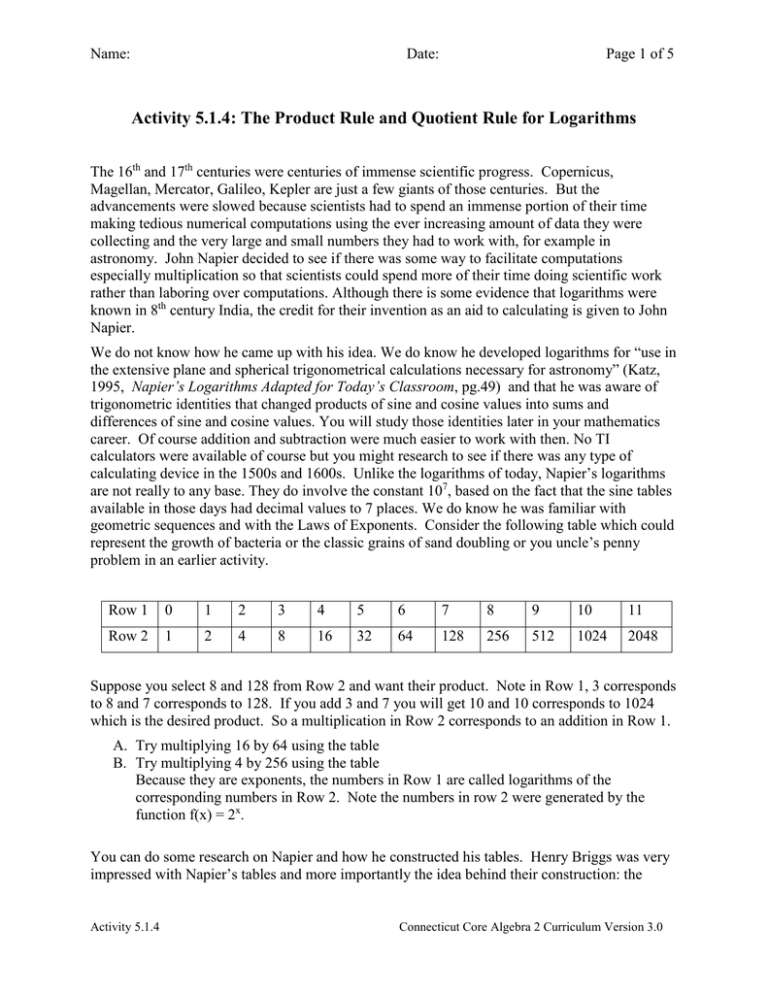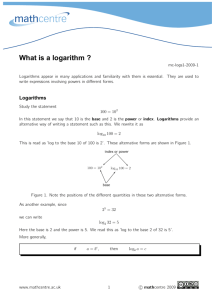Activity 5.1.4 - Connecticut Core Standards
advertisement

Name: Date: Page 1 of 5 Activity 5.1.4: The Product Rule and Quotient Rule for Logarithms The 16th and 17th centuries were centuries of immense scientific progress. Copernicus, Magellan, Mercator, Galileo, Kepler are just a few giants of those centuries. But the advancements were slowed because scientists had to spend an immense portion of their time making tedious numerical computations using the ever increasing amount of data they were collecting and the very large and small numbers they had to work with, for example in astronomy. John Napier decided to see if there was some way to facilitate computations especially multiplication so that scientists could spend more of their time doing scientific work rather than laboring over computations. Although there is some evidence that logarithms were known in 8th century India, the credit for their invention as an aid to calculating is given to John Napier. We do not know how he came up with his idea. We do know he developed logarithms for “use in the extensive plane and spherical trigonometrical calculations necessary for astronomy” (Katz, 1995, Napier’s Logarithms Adapted for Today’s Classroom, pg.49) and that he was aware of trigonometric identities that changed products of sine and cosine values into sums and differences of sine and cosine values. You will study those identities later in your mathematics career. Of course addition and subtraction were much easier to work with then. No TI calculators were available of course but you might research to see if there was any type of calculating device in the 1500s and 1600s. Unlike the logarithms of today, Napier’s logarithms are not really to any base. They do involve the constant 107, based on the fact that the sine tables available in those days had decimal values to 7 places. We do know he was familiar with geometric sequences and with the Laws of Exponents. Consider the following table which could represent the growth of bacteria or the classic grains of sand doubling or you uncle’s penny problem in an earlier activity. Row 1 0 1 2 3 4 5 6 7 8 9 10 11 Row 2 1 2 4 8 16 32 64 128 256 512 1024 2048 Suppose you select 8 and 128 from Row 2 and want their product. Note in Row 1, 3 corresponds to 8 and 7 corresponds to 128. If you add 3 and 7 you will get 10 and 10 corresponds to 1024 which is the desired product. So a multiplication in Row 2 corresponds to an addition in Row 1. A. Try multiplying 16 by 64 using the table B. Try multiplying 4 by 256 using the table Because they are exponents, the numbers in Row 1 are called logarithms of the corresponding numbers in Row 2. Note the numbers in row 2 were generated by the function f(x) = 2x. You can do some research on Napier and how he constructed his tables. Henry Briggs was very impressed with Napier’s tables and more importantly the idea behind their construction: the Activity 5.1.4 Connecticut Core Algebra 2 Curriculum Version 3.0 Name: Date: Page 2 of 5 reduction in time for calculating with scientific data. He traveled more than 400 miles which was quite a feat in those days to meet Napier. The Napier logarithm of 1 was not 0 and that was a problem. Brigg’s suggested using 10 as a base so the logarithm of 1 would be 0. Napier agreed but because of his age, ill health and because he had already spent so much of his life making his tables that task fell to Briggs. Briggs developed tables for the integers from 1 to 20000 and 90000 to 100000. Briggs developed tables for integers from 1 to 20000 and 90000 to 100000. Another mathematician, Vlacq filled in the gaps. The tables held decimals to 14 places. Use your calculator to get the log 11 or log 55. Note the answers are not nice. Tables with 20 places of accuracy were not completed unit 1924. 1. Evaluate the following pairs of expressions: a. log2 4 + log2 32 and log2 128 b. log2 8 + log2 16 and log2 128 c. log 100 + log 10000 and log 1000000 d. log 0.1 + log 10 and log 1 e. log 0.01 + log 1000 and log 10 2. Do you see a potential relationship between the two expressions in number 1? If you do, please make a general conjecture. _______________________ If you do not, talk with a neighbor. 3. Now let us see if we can prove your conjecture. Does log A + log B = log (AB)? Also what must be true about A and B? Think of the domain of the graph of the logarithm function.__________________ a. Let log A = M and log B = N b. Log A = M can be written as 10M = A Why? c. Log B = N can be written as 10N = B Why? d. AB = 10M 10N Why? e. AB = 10M+N Why? f. log (AB) = log 10M+N= M + N Why? g. BUT log A = M and log B = N so log AB = log A + log B Why? 4. Rewrite as the sum of logarithms using your rule. a. log 2 (3 ∙ 6) b. log 2 10 Activity 5.1.4 Connecticut Core Algebra 2 Curriculum Version 3.0 Name: Date: Page 3 of 5 c. log10 50 d. log 3 9𝑥 5. Write as a single logarithm. a. log 2 7 + log 2 5 𝑥 9 b. log 3 3 + log 3 𝑦 c. log 2 3 + log 3 2 d. log10 25 + log10 2 + log10 4 6. Evaluate the following pairs of expressions: a. log 1000 – log 10 and log 100 b. log 10000 – log 100 and log 100 c. log3 81 – log3 27 and log3 3 d. log2 32 – log2 4 and log2 8 7. Do you see a potential relationship between the two expressions in number 6? If you do, please make a conjecture. If you do not, talk to a neighbor. __________________________ 8. Now let us see if we can prove your conjecture. Does: log A - log B = log (A/B)? a. Let log A = M and log B = N Why? b. _____________________________ c. _____________________________ d. _____________________________ e. _____________________________ f. _____________________________ g. _____________________________ Activity 5.1.4 Connecticut Core Algebra 2 Curriculum Version 3.0 Name: Date: Page 4 of 5 9. Rewrite as the difference of logarithms. 3 a. log 2 5 8 b. log 3 25 𝑥 c. log10 𝑧 1 d. log 2 2 This one can also be simplified once rewritten 10. Write as a single logarithm and simplify where possible. a. log 2 10 − log 2 5 5 b. log10 𝑥 − log10 1 20 𝑥 5 c. log10 30 − log10 3 d. log 3 18 − log 3 2 11. Write as a single logarithm. a. log 2 12 + log 2 5 − log 2 10 1 b. log 2 𝑥𝑦 − (log 2 9 − log 2 18) + log 2 𝑥 c. log10 𝑥 + log10 𝑦 − log10 𝑧 d. log 3 10 − log 3 14 − log 3 7 Activity 5.1.4 Connecticut Core Algebra 2 Curriculum Version 3.0 Name: Date: Page 5 of 5 12. The fifteenth century mathematician John Napier invented logarithms to simplify the calculations of complex expressions involving multiplications and divisions by changing them to additions and subtractions. Explain how the logarithm properties he created accomplished this by looking at several examples. 13. The two laws you have discovered are stated in the box. BUT there are restrictions on b, A and B. What are they? Add them in the box. log 𝑏 𝐴 ∙ 𝐵 = log 𝑏 𝐴 + log 𝑏 𝐵 𝐴 log 𝑏 = log 𝑏 𝐴 − log 𝑏 𝐵 𝐵 Activity 5.1.4 Connecticut Core Algebra 2 Curriculum Version 3.0







